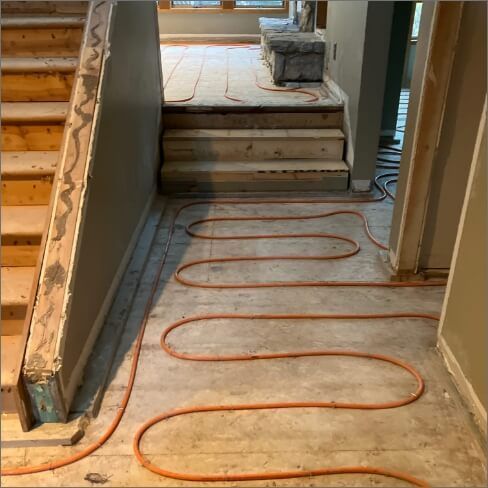Radiant Floor Heating
You'll Be Glad You Called Us First!
Hydronic (Radiant Heat) Flooring Systems: Enhancing Home Comfort and Efficiency
Hydronic flooring systems, also known as radiant heat flooring, represent a sophisticated and highly efficient method for heating homes. Unlike traditional forced-air systems that heat the air, hydronic systems use heated water to warm floors directly, providing a consistent and comfortable heat distribution throughout the space. This article explores the benefits, operation, and considerations of hydronic aka radiant heat flooring systems, offering insights for homeowners considering this innovative heating solution.
We include great service guarantees on all our tub and shower work as well.

How Hydronic Radiant Heat Flooring Works
Hydronic systems circulate warm water through a network of tubing laid beneath the floor surface. The heat from the water radiates upward, warming the floor and the room above. The water is heated by a water heater and a return manifold system and can be controlled by zoning valves or thermostats to manage the temperature in different areas of the home. This method of heating provides an even, gentle warmth, eliminating the hot and cold spots commonly associated with traditional heating systems.
Benefits of Hydronic Radiant Heat Flooring
- Efficient Heating: Hydronic systems are often more energy-efficient than forced-air systems because water is a more effective medium for conveying heat than air. The direct heating of the floor also minimizes heat loss, leading to lower energy bills.
- Improved Comfort: The even distribution of heat from the ground up enhances comfort, eliminating cold floors and reducing the movement of dust and allergens that can occur with forced-air systems.
- Silent Operation: Unlike systems that rely on blowers or fans, hydronic radiant heating operates silently, enhancing the tranquility of your living space.
- Design Flexibility: With no need for radiators or air ducts, homeowners have greater freedom in designing their interiors. Additionally, radiant heat systems can be installed under various types of flooring, including tile, stone, and wood.
Considerations for Installation and Maintenance
- Initial Investment: The cost of installing a hydronic radiant heat flooring system can be higher than traditional heating systems, particularly in existing homes where the floors must be replaced or significantly modified. However, the long-term energy savings can offset the initial expense.
- Water Heater Requirements: A high-quality, efficient water heater is crucial for the system's operation. The choice of the unit and its type will affect the system's efficiency and overall heating costs.
- Flooring Materials: While hydronic systems can work under most types of flooring, some materials, like thick carpet, can insulate the floor and reduce the system's effectiveness. Choosing the right flooring material is essential for optimal heat transference.
- Maintenance: Regular maintenance of the water heater and the hydronic system including periodic checks on the piping for leaks or damage are necessary to ensure the system's longevity and efficiency.

Making The Final Decision To Go With Hydronic Flooring Systems
Hydronic radiant heat flooring systems offer an appealing solution for homeowners looking for an efficient, comfortable, and aesthetically pleasing heating option. The gentle and evenly spread warmth provided by these systems can transform the living environment, making spaces more inviting and comfortable during the cold months. While the initial setup requires careful planning and investment, the benefits of a hydronic system—ranging from energy savings to improved comfort and air quality—make it a worthwhile consideration for any homeowner.


